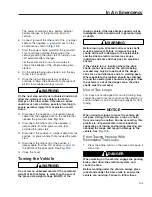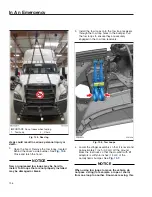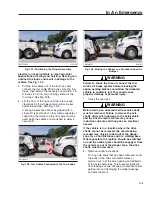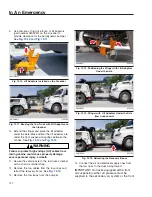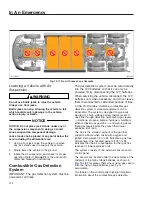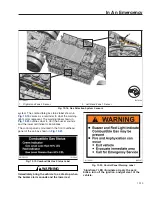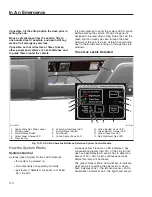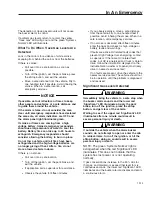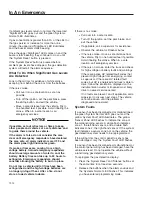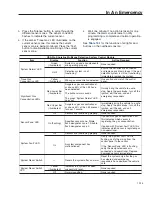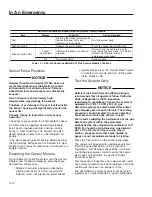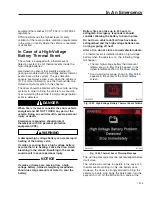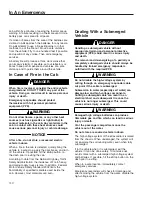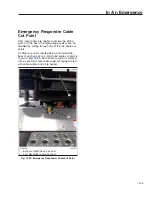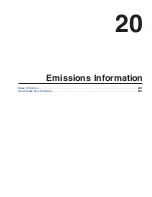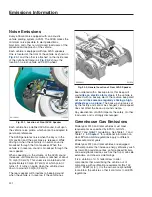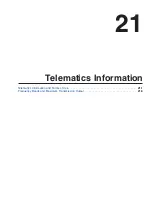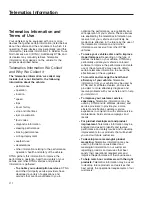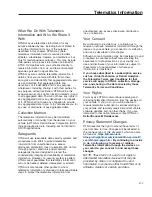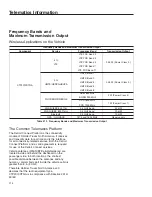
cab within five minutes of seeing the thermal popup
warning. A failure resulting in a thermal event in one
battery pack can spread to all packs.
If smoke or flames from the area of the batteries are
visible, do
not
approach the batteries for any reason.
Do
not
attempt to use a fire extinguisher or other
methods to put the fire out. Move a safe distance
from the vehicle, fifty to one hundred feet if possible,
and upwind of any smoke. Then call emergency
services.
A battery fire will produce a thick, dark smoke that
can impair visibility. If possible, set out reflectors or
flares to keep other people and vehicles at a safe
distance and to guide them around the vehicle.
In Case of Fire in the Cab
DANGER
When fire is involved, consider the entire vehicle
energized and DO NOT TOUCH any part of the
vehicle. Doing so could result in severe personal
injury or death.
Emergency responders should protect
themselves with full personal protective
equipment (PPE).
WARNING
Do not allow flames, sparks, or any other heat
sources (such as cigarettes or light bulbs) to
contact materials in the cab. Any materials in the
cab in contact with these heat sources could
cause serious personal injury or vehicle damage.
NOTICE
After a fire, do not store a recovered electric
vehicle indoors.
When a fire in the cab is detected, quickly bring the
vehicle to a safe stop, apply the park brake, and turn
off the vehicle. If possible, hit the eStop button on
the dash prior to exiting the cab.
According to data from the National Highway Traffic
Safety Administration, the incidence of fire in heavy-
and medium-duty trucks is rare. In addition, Federal
Motor Vehicle Safety Standard #302 limits the
flammability of specified materials used inside the
cab. However, most materials can burn.
Dealing With a Submerged
Vehicle
DANGER
Handling a submerged vehicle without
appropriate training and personal protective
equipment (PPE) could result in serious injury
and death.
The removal and de-energizing of a partially or
completely submerged vehicle should always be
handled by trained emergency responders
outfitted with the required PPE.
WARNING
Do not disable the high-voltage system by
cutting through an emergency responder cable
cut point if the cable is submerged.
Submersion in water (especially salt water) can
damage low and high voltage components.
Cutting a submerged cable can result in an
electrical short and subsequent fire once the
vehicle is no longer submerged. This could
cause serious injury or death
WARNING
Damaged high voltage batteries can produce
flammable gas and fire which can lead to serious
injury or death.
Vent the passenger compartment once the
vehicle out of the water.
Do not store a recovered vehicle indoors.
The high voltage system of the eCascadia is isolated
from the chassis. When undamaged, the system will
not energize the surrounding water, even when fully
submerged.
If in the vehicle when it is submerged, exit the
vehicle if it can be done safely. To minimize risk,
avoid contact with a submerged high voltage system
and batteries. If possible, hit the eStop button on the
dash prior to exiting.
When in a safe location, immediately contact
emergency services.
Emergency responders will check for damage and,
after removing the vehicle from the water, disable the
high-voltage system.
In An Emergency
19.17
Summary of Contents for PX113064S T 2016
Page 4: ......
Page 10: ......
Page 18: ......
Page 58: ......
Page 86: ......
Page 112: ......
Page 122: ......
Page 142: ......
Page 154: ......
Page 155: ...12 Steering System Power Steering System 12 1...
Page 158: ......
Page 159: ...13 eAxle eAxle 2 Speed Transmission 13 1...
Page 176: ......
Page 190: ......
Page 202: ......
Page 222: ......
Page 223: ...20 Emissions Information Noise Emissions 20 1 Greenhouse Gas Emissions 20 1...
Page 229: ......
Page 236: ......


